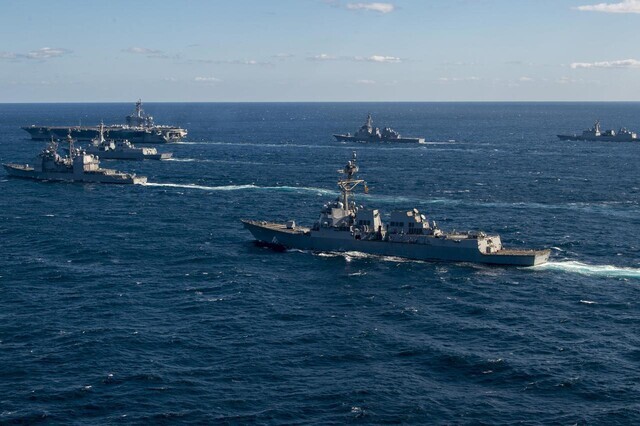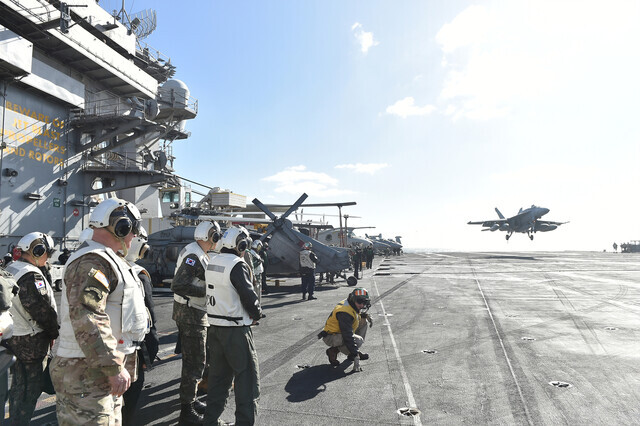hankyoreh
Links to other country sites 다른 나라 사이트 링크
S. Korea, US and Japan hold naval drills in show of joint response to N. Korean threats

South Korea, the US and Japan conducted a three-day trilateral naval exercise in international waters south of Jeju Island from Monday to Wednesday, with the USS Carl Vinson supercarrier taking part, the South Korean Joint Chiefs of Staff announced Wednesday.
The Joint Chiefs called the exercise “significant in both boosting capabilities to respond to North Korean nuclear weapons and missiles and showing joint response capabilities and commitment with regard to North Korean threats.”
The nine warships participating in the exercise were two Sejong the Great-class destroyers affiliated with the Republic of Korea Navy, the USS Carl Vinson and four other ships affiliated with the US Navy’s Carrier Strike Group 1, and two Japan Maritime Self-Defense Force ships, including a Kongo-class destroyer.
The trilateral maritime exercise was the second in two months following a previous one in November, which also included the USS Carl Vinson, a Nimitz-class nuclear-powered aircraft carrier.
On the first day, the chairman of South Korea’s Joint Chiefs of Staff, Kim Myung-soo, visited the USS Carl Vinson to review the exercises.
“Maritime exercises by South Korea, the US and Japan have centrally contributed to deterring and responding to North Korea’s nuclear and missile threats, which have been advancing by the day,” he said at the time.
According to the chiefs, the exercise focused on strengthening trilateral cooperation to establish a rule-based international order and respond to maritime security threats, including blocking the maritime transportation of weapons of mass destruction.

The trilateral exercise was the first conducted since South Korean, US and Japanese military authorities jointly formulated a multi-year exercise plan to carry out the terms of their agreement reached at Camp David last August, where they agreed to hold regular trilateral military exercises.
During the Moon Jae-in administration, South Korea did not take part in trilateral exercises due to concerns about excessive Japanese interference in Korean Peninsula issues.
But since current President Yoon Suk-yeol’s administration was launched in May 2022, the three sides have engaged in sea and air exercises, including missile warning and anti-submarine drills.
The situation has raised concerns among some that the three appear to be racing into a quasi-military alliance.
By Kwon Hyuk-chul, staff reporter
Please direct questions or comments to [english@hani.co.kr]

Editorial・opinion
![[Correspondent’s column] The real reason the US is worried about Chinese ‘overcapacity’ [Correspondent’s column] The real reason the US is worried about Chinese ‘overcapacity’](https://flexible.img.hani.co.kr/flexible/normal/500/300/imgdb/original/2024/0510/5217153290112576.jpg) [Correspondent’s column] The real reason the US is worried about Chinese ‘overcapacity’
[Correspondent’s column] The real reason the US is worried about Chinese ‘overcapacity’![[Editorial] Yoon’s gesture at communication only highlights his reluctance to change [Editorial] Yoon’s gesture at communication only highlights his reluctance to change](https://flexible.img.hani.co.kr/flexible/normal/500/300/imgdb/original/2024/0510/7717153284590168.jpg) [Editorial] Yoon’s gesture at communication only highlights his reluctance to change
[Editorial] Yoon’s gesture at communication only highlights his reluctance to change- [Editorial] Perilous stakes of Trump’s rhetoric around US troop pullout from Korea
- [Guest essay] Preventing Korean Peninsula from becoming front line of new cold war
- [Column] The state is back — but is it in business?
- [Column] Life on our Trisolaris
- [Editorial] Penalties for airing allegations against Korea’s first lady endanger free press
- [Editorial] Yoon must halt procurement of SM-3 interceptor missiles
- [Guest essay] Maybe Korea’s rapid population decline is an opportunity, not a crisis
- [Column] Can Yoon steer diplomacy with Russia, China back on track?
Most viewed articles
- 1Korea likely to shave off 1 trillion won from Indonesia’s KF-21 contribution price tag
- 2Nuclear South Korea? The hidden implication of hints at US troop withdrawal
- 3[Editorial] Perilous stakes of Trump’s rhetoric around US troop pullout from Korea
- 4With Naver’s inside director at Line gone, buyout negotiations appear to be well underway
- 5In Yoon’s Korea, a government ‘of, by and for prosecutors,’ says civic group
- 6[Column] ‘Choson’: Is it time we start referring to N. Korea in its own terms?
- 7‘Free Palestine!’: Anti-war protest wave comes to Korean campuses
- 8How many more children like Hind Rajab must die by Israel’s hand?
- 9Overseeing ‘super-large’ rocket drill, Kim Jong-un calls for bolstered war deterrence
- 10[Photo] ‘End the genocide in Gaza’: Students in Korea join global anti-war protest wave